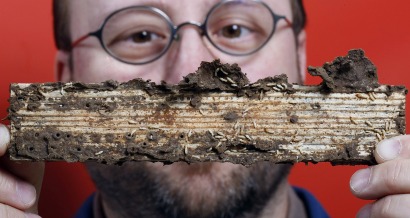
Cellulosic ethanol is a fuel produced from the inedible portions of plants, material often discarded as waste. The process often involves genetically engineered microbes such as bacteria or fungi to break down sugars found in the cell walls of the plants.
Before the microbes can do their work, however, they must first get past lignin, the compound largely responsible for making wood “woody” instead of soft. During ethanol production, lignin molecules are clumped around the sugar molecules, forming a barrier the microbes often can’t penetrate.
So, the material must first be exposed to heat and steam or caustic acids and bases to break that barrier down. These extra steps make the process much more expensive and often generate hazardous waste.
However, in an article published this month in the scientific journal Plos One, researchers Michael Scharf, Zachary Karl, and Drion Boucias from the Entomology and Nematology Department at the University of Florida, and Amit Sethi from the Department of Entomology at Purdue University have determined that enzymes found in termite salivary tissues may be able to accomplish the same task, and at room temperature.
“Once we figure out the best way to integrate this sort of enzyme into the process, it could drop the cost of producing cellulosic ethanol significantly,” said UF entomologist Mike Scharf, who led the research, a collaboration between the two universities and the biotechnology company Chesapeake-PERL Inc. The work was funded by the US Department of Energy and The Consortium for Plant Biotechnology Research Inc.
Significant contribution to biofuel development
“This is definitive and original research that could realistically be a significant contribution to green energy,” said James Preston, a University of Florida microbiology professor who studies enzymes in bacteria that break down plant material. “It’s this kind of work that keeps pushing cellulosic ethanol toward practicality.”
The study follows more than two years of work to identify nearly 7,000 genes associated with the termite gut. The researchers are wading through the genes to identify which ones are associated with enzymes that could be useful, and they are hopeful that many more such exciting discoveries are yet to come.
“We still have a long way to go before we’re finished,” Scharf said. “But, in the meanwhile, we can start putting what we have discovered to good use.”
In the Plos One article, the researchers explain that: “Our findings provide important new evidence of synergistic collaboration among enzymes in the release of fermentable monosaccharides from wood lignocellulose. These monosaccharides (glucose and pentoses) are highly relevant to 2nd-generation bioethanol production”.
They go on to say that their “findings contribute important new insights towards the development of termite-derived biofuel processing biotechnologies”.
A 2009 report by Sandia National Laboratories predicted that cellulosic ethanol could replace about 30 percent of the US’s gasoline alone by 2030, if the price of production could be reduced.
For additional information:

